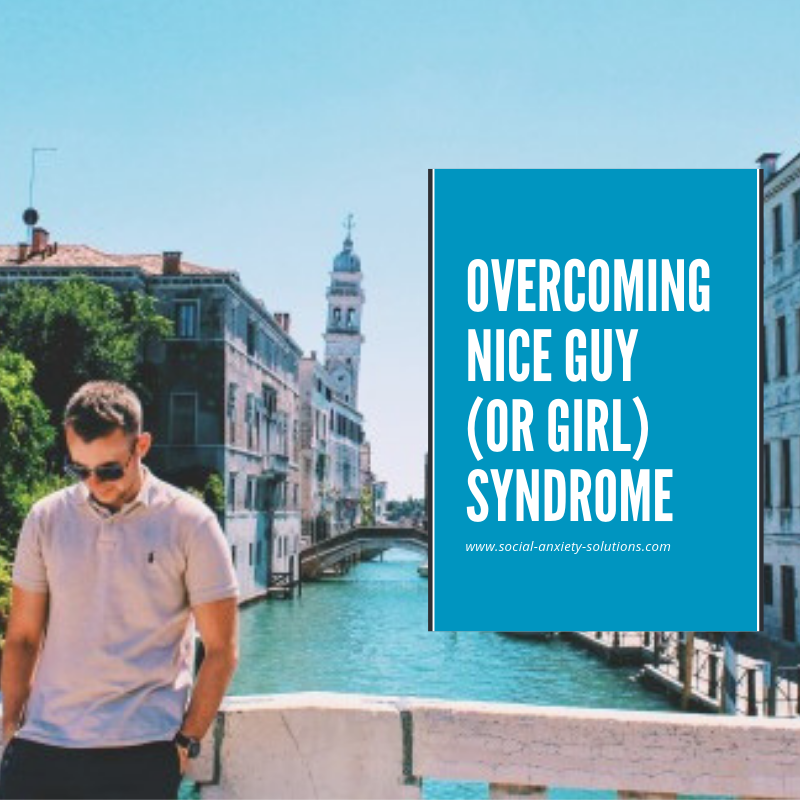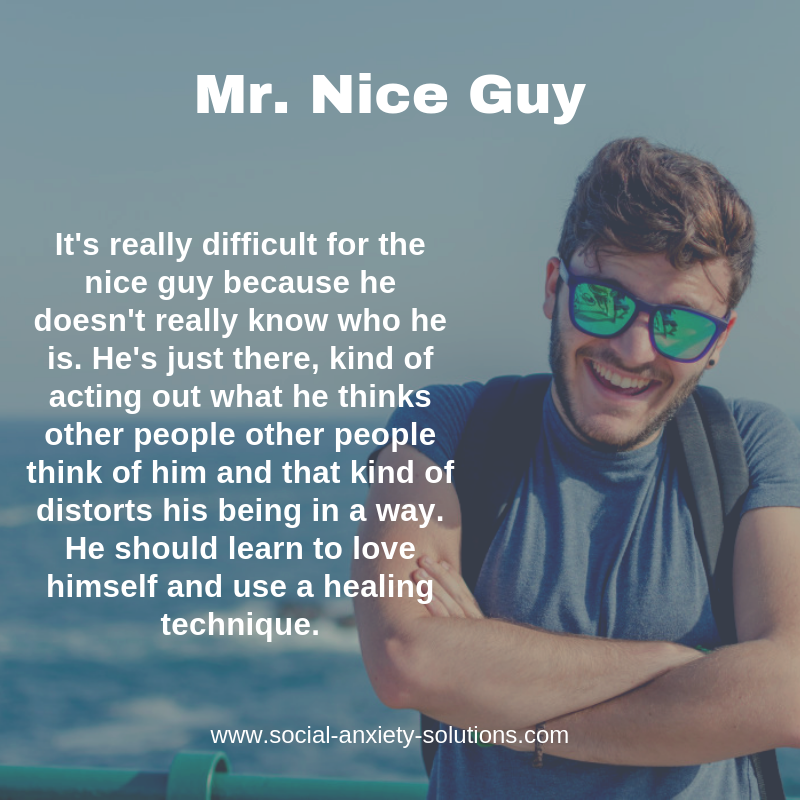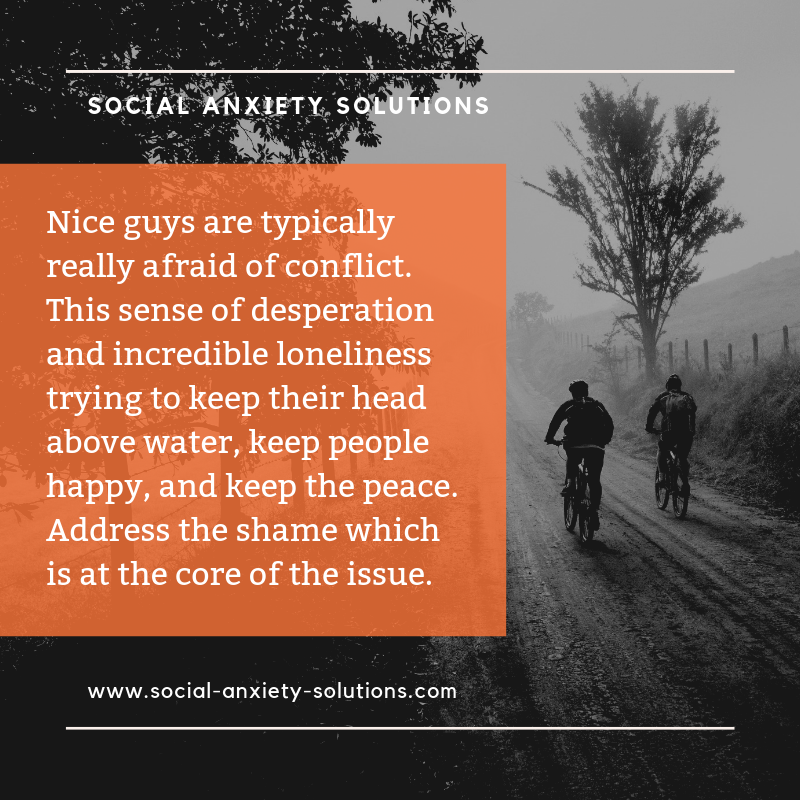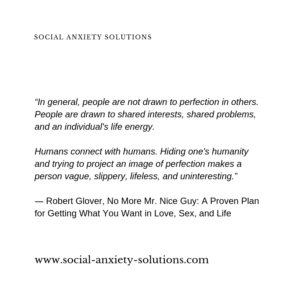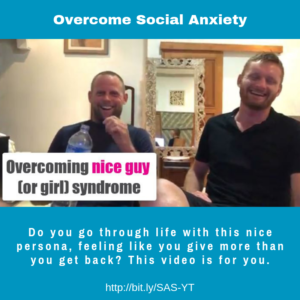SUMMARY
In this post, my buddy Tom Woodfin and I discuss the nice guy syndrome.
A topic based on a book called No More Mister Nice Guy: A Proven Plan for Getting What You Want in Love, Sex, and Life by Dr. Robert Glover.
If you feel you go through life with this nice persona and you struggle with having boundaries, feeling like you give more than you get back, or you have indirect or passive-aggressive behaviors, then this post is for you.
Tom and I discuss in depth:
- What is the nice guy (or girl) syndrome?
- Two anxiety patterns and toxic shame core
- Fear of Conflict
Tom is a former MMA-fighter and social anxiety disorder sufferer turned inner journey expert. You can find him at his website here.
FULL TRANSCRIPTION
Sebastiaan: Hi, my name is Sebastiaan van der Schrier from social-anxiety-solutions.com and I’m a former social anxiety disorder sufferer and a social east coach or social confidence coach however you want to call it and I just ran our first ever social confidence retreat. It was really awesome, and I did that with a particular person and his name is Tom.
Tom: Oh, yeah, this is me.
Sebastiaan: That’s the one.
Tom: Hello.
Sebastiaan: That’s the one. And under retreat he was talking with some of the people on the retreat about the nice guy pattern. Hard time getting it off my… There’s an author of a particular book called “No more Mr. Nice Guy”.
That’s not a pattern I particularly have dealt with myself. I’m more of the opposite and being a dick sometimes. I need a book like “How to not be a dick?”
Tom: We balance each other.
Sebastiaan: Yeah, we balance each other quite well. But we were talking about interviewing him on my podcast.
Tom: Yeah, Robert Glover.
Sebastiaan: Robert Glover. And since I haven’t read the book it would be good to have Tom as a guest interviewer on the podcast so he can interview Robert Glover off the “No more Mr. Nice Guy” book. That’s what we’re talking about. So, we’re talking about “the nice guy” syndrome a bit and I thought it would be nice to have a little video about that.
In the coming 15 minutes or 10, hopefully under 15.
Tom: To keep it short. It’s difficult for me.
What is the nice guy (or girl) syndrome?
Sebastiaan: Yeah, me too. I’ll just talk about one particular pattern that really stands out and that I’m aware of, that I’ve worked with guys and that is people pleasing. By the way also with women and it could also be “the nice girl”.
People-pleasing and difficulties saying “no”. Basically, people pleasing is like oh please give me your approval, I need your approval because if you don’t approve of me I don’t approve of myself and therefore I don’t feel safe and when I don’t feel safe that results in anxiety, nervousness, tension, awkwardness. That’s a pattern.
Another one is or those two are very linked together is like difficulty saying no.
If you can’t say no confidently then when you’re requesting something in your honest truth is a “no” and you’re going to say yes, you’re going to go against yourself and not having that boundary of where you say “No, that’s not going to work for me” leads also to you not feeling safe because in those kinds of scenarios where you want to say no but you can’t say no, that’s going to lead you to feel anxiety and uncomfortable feelings and that’s not nice. That’s a pattern.
Tom: Yeah, well, I’d say the way that you describe the boundaries thing and the importance of being able to actually say “no” and for nice guys and people please in general it’s a very difficult thing and one of the things that it leads to is this buildup of resentment because as one of the things that Robert Glover says in the book is the nice guy isn’t actually nice.
Like you said a kind of ironic title almost and basically the nice guy thinks that he has to act nice in order to get his needs for love met.
Basically, they go on this kind of mission of like molding into what they think other people think that they should be, acting without their own kind of authenticity and this craziest kind of buildup of resentment and almost like this fakeness.
It’s really difficult for the nice guy himself because he doesn’t really know who he is. He doesn’t really know who he is, he’s just there kind of acting out what he thinks other people one of them and that kind of distorts his being in a way.
So, it’s very difficult for him to kind of trust himself and it’s very difficult for people to trust him. And when somebody doesn’t respond the way that he thinks that they ought to respond with by loving him then this resentment and rage and anger that’s built up over time just kind of explodes out.
So, the nice guy is typically kind of like an unreliable character like people don’t really know where they stand with him, they’re not sure if he’s telling the truth or that he’s just being nice to kind of appease them and avoid the rage or the discomfort that you might feel if somebody actually dislikes him. Yeah, it’s kind of a difficult thing.
Sebastiaan: Gotcha, okay. I can relate to part of that. By the way, I’m kind of joking, I’m not always a dick. What you’re basically saying is like well, a nice guy is acting based upon what he has learned is okay and acceptable which is going to get people’s approval and that kind of acting from my perspective which I can very much relate to which I think you can also relate to him. By the way pretty much anyone in society also to people with very little social anxiety, we all want to look good and not look bad. It’s just to whatever degree you have that problem.
Tom: Someone on the spectrum, it’s not like a black or white thing.
Sebastiaan: Yeah, exactly. And that as you were talking about, that is something that is very difficult to connect to because it’s fake, it’s not genuine. You’re behaving in order to get approval and to avoid disapproval and that is not easy to be able to connect to.
Tom: It’s very hard for people to connect because they are actually connecting to anything real and that’s where kind of real connection comes in where people are actually being honest with us and that is really important. I think the nice guy feels like generally he has to hide his mistakes and so he creates this kind of like a fake persona and really just represses a lot of emotion. One of the things that Robert Glover said, one of the things that stood out in his book for me was he said that if he was to write another book it will be on how to manage anxiety because when you’re trying to hide that much of yourself, it’s almost also like a kind of a perfectionism issues.
If you think that you have to be perfect that creates a lot of anxiety because it’s like this is the tip of the iceberg and people better not see what’s underneath. It’s like terrible and unacceptable and unlovable and all these things.
Two anxiety patterns and toxic shame core
Sebastiaan: Yeah, I spoke about this with David for a fair bit. By the way this is very interesting I’m like should I look at the camera or your face, but I’ll go back and forth a bit. I spoke about that with Dr. David Lake, my mentor, psychotherapist, qualified man, let’s just say that. He knows his business. We were talking about anxiety and he was differentiating between two kinds of anxieties which I found very interesting. He’s like there’s the stronger fear-based anxiety and there’s the anxiety that it comes from not being okay with yourself.
So, if you got beat up when you were 13 years old then when you’re 22 years old and you’re around the person that looks similar to the guys that beat you up you’re going to have a really strong fear response because your brain is telling you to get the hell out of here or you’re going to get beat up again. That’s a particular strong fear-based anxiety which is different from the perfectionism kind of I have to be this way, I can’t be that way, it should be this way, ought to be that way.
All of these rules about how you should be and how it shouldn’t be.
That’s a different kind of anxiety and often they are interlinked for people. So, it’s like a social perfectionism, social anxiety and the more of this business you’ve got going on the more anxious you have and more of like an unraveling it takes to get to the core where you feel free to express yourself as is. Thoughts come up you blurt them out rather than filtering every little thing that you say, “Oh, wow, I have this thought that I want to say but is it really going to be acceptable? What if it’s not cool to say that? Like that kind of stuff.
Tom: Everything is designed to create this image of yourself that you think you need to be so people will love you properly. The nice guys kind of acting out of this thing that Glover talks about, the toxic shame call like the nice guys identity sense if you want to call it like that, he’s like based in this this toxic shame and that kind of comment.
He says that kind of comes out in two ways so it can come out as their “I’m so good nice guy” if well, he has this toxic shame buddy almost like overcompensate for that by being like quite arrogant or like being over the top. I’m just a bad nice guy where they’re nice guys like wallows in this, oh, look I’m so terrible upon me and almost like a kind of a…
Sebastiaan: We are in a good balance.
Tom: We worked that out pretty well.
Sebastiaan: Nice.
Tom: And I notice that like that pattern happening in me but at the same time it’s like that will to just come down really hard on yourself and really heavy on yourself and look at how bad you’re doing and actually this shame once the nice guy starts to get into its kind of deep inner work, it’s like this shame is actually masking this absolute terror of I’m unlovable or like the thing the who I am as a being is like not worthy of love.
So, this complete terror and panic of like not going to get his needs for love met. So, yeah, it’s pretty heavy things.
Sebastiaan: Yeah, because this shame is an emotion that is telling you “Hey, you’re being wrong so correct your behavior so that you’re going to be okay”. Shame on you, right?
Like a common phrase of parents to correct. That core of shame that he talks about from my experience that’s like the root of where all of these perfectionistic patterns than come from. The default is then I’m not okay the way I am.
So, that’s the foundation that your brain operates from and then it’s like all right well, since I’m not okay the way I am, what can I do in order to get my need for acceptance and get my need for love fulfilled anyway?
Okay, well, use these kinds of words, popular words that I hear the popular kids use and I’m going to use those words as well. So, say a lot of “fuck”. So, I say a lot of “fuck”. Walking in this particular way, stand with your shoulders straight. Don’t associate yourself with these people, associate yourself with those people. Listen to this kind of music, don’t listen to that kind of music. Use these kinds of clothing.
That’s kind of how it starts in puberty, but it comes a lot more sophisticated as you get older, but it starts with that same foundation interesting.
Fear of Conflict
Tom: Well, yeah, the whole thing in this shame core and yet your life becomes a race to try to keep up with what you think other people’s opinions of you are and that was a sense of desperation and just incredible loneliness as well. It’s like I’m just trying to like to keep my head above water, just keep people happy and keep the peace.
Nice guys are typically really afraid of conflict and I like I noticed this very, very early on in my life that I was afraid with conflict and so I decided to go train MMA and I was like all right, that helps me out physically a lot but it didn’t deal with the underlying pattern of like I’m still afraid of conflict.
Sebastiaan: Which is very interesting because he fought in the ring for money and I felt like let’s try to throw each other on the floor just that and also like…
Tom: Let’s try to kill each other.
Sebastiaan: Mix martial arts, yeah, actually tried to knock each other out, and do anything the only thing you couldn’t do is scratch people.
Tom: Those are minimal rules.
Sebastiaan: But yeah, think about that. Someone who was training for years in order to be able to fight in the ring, face his biggest fears and then yet still remains with these fears because the underlying stuff hadn’t been dealt with.
Tom: Yeah, seriously, it’s crazy like when I think about it. When I actually came back I was like right look this is a big problem and it got highlighted by it was going through different relationships and different relationships would kind of bring up certain stuff but it was almost like I was in maybe denial about it until one relationship kind of brought it all out to the surface and even still it was like fairly stubborn so it took me a while to kind of think about how actually I see how if I just tried to make her happy then maybe she will love me and return.
That just made her more and more annoyed and angry and I was like why isn’t this working, why isn’t this working?
And then I started to get bitter and resentful and angry and thinking like I’m giving all this stuff, she should be responding in a positive way and loving me the way that I think that she should be just because I think that she should be in like when you say it like that it’s kind of crazy but it wasn’t until I just sat down and decided like okay, I actually need to address this. I actually need to address first off, the anxiety and the terror… maybe not first off but the several components of it.
So, there was the shame and then there was surrounded by anxiety and terror and terror of not being loved and then the anxiety of not being found out. But also, all this rage, all this repressed rage that was just so far out in my dissociated feels because I thought I’m a calm guy, I’m a nice guy.
My own identity was around I’m this nice guy and I thought I’m not the kind of guy who gets angry or stressed about things but it’s really not true. It’s just I was just subverting and pushing it under into some place that I couldn’t feel it but obviously it was there because it was affecting me deeply and like when it got touched I would kind of explode and it would come out.
It wasn’t until I actually started to address the idea that you know what?
Maybe I can be just as bitter and resentful and angry and terrified and there’s all these things going on with me then that’s when it actually started to move through.
So, I have to sit down and feel it and I was like tapping through and doing also other modalities and hell of a lot of work and it’s still a work in progress. But it wasn’t until I started to address that, sit down and feel the things that I needed to feel that I had built up over the years that it started to move.
Sebastiaan: Yeah, in other words you were processing your painful past, the path of the past, living through that.
I had a blushing problem for the longest time, and it was very difficult to get a handle on it but eventually with persistence it does work out. That’s the good news. That’s not inclusion we’re running over time 20 minutes.
Tom: Yeah, well, we’ve persisted, and persistence is the message.
Sebastiaan: Yeah, exactly. Yeah, nice one, nice one.
Tom: It’s a good message.
Sebastiaan: So, there you go. Be persistent.
Tom: Yeah, be persistent. It’s a good start to a final conclusion.
In Summary
Sebastiaan: Anyway, as an example if you have a problem with saying “no” that is because your brain has pain associated with saying “no”.
Maybe when you were younger a “no” meant that your dad would get really pissed off with you. “How dare you disrespect me by saying no? Or “I’m the parent, you’re the child, you’re supposed to listen”. That comes with a lot of negative emotion that gets stuck into your system. Now that happens over time and you learn “Okay, I can’t say no”.
And that’s been something that you live with in your 20s, 30s, 70s if you don’t address it. It won’t go away by itself most likely, so you need to address it. How do you address it? You use a variety of techniques.
One of them, for example, tapping. I talked about this on my channel, it’s a psychological form of acupuncture that looks really bizarre and silly but it’s amazingly effective. The process negative emotions, stuck negative emotions from the past you bring them up, so you open the file from back then and you do the tapping and the tapping releases the stuck emotions from the past and you process it. Once there is no longer pain associated with saying “no” it can’t just come out. Your brain won’t stop you from saying it and then you’ll be surprised.
You’re like “Wow, I said no there, and it actually wasn’t a problem. It’s amazing.
That also starts to update your whole identity, you’ll start to see yourself differently and that can be a gradual change, it could be a profound change, it just depends on what kind of pattern we are working on. My understanding is like the nice guy pattern consists of a bunch of them. Not being able to say “no” is just a big one of them.
Tom: Yeah, yeah. I would say for me if I was to kind of give of what can people start doing now, one of the things is for years I had this idea in my head of who I thought I was and it’s like kind of put that down for a moment and it’s going to sound really cheesy and like hippy like but the answer is just almost like self-love but it just sounds too kind of…
Sebastiaan: Airy-fairy.
Tom: Airy-fairy… Just not nonspecific enough but it’s really like there’s a bunch of parts of you that need to be felt and this dimensions of you that you can kind of feel compassion for those parts of you from so to explore those different dimensions of your being through with somebody who kind of knows how to do that is really important.
I’m just getting in touch with those feelings because one of the things is like it just it doesn’t feel like you’re fully there and it’s like you’re just on the surface and there’s a big hole in the middle and it’s that thing that is not addressed that you don’t feel like you are quite fully in life and that’s it. That’s what those things are. It’s just all those feelings that have yet to be felt. So, you need to sit down and make some time and space.
I worked with breath work when I found that. Very useful and embodied movement, embodied exercises. The way that you use your body is almost like the shape of your brain as far as I understand it.
And so, to use all of these practices and a hell of a lot of tapping as well, I find it really, really useful. It’s just do what you can, something that resonates with you to get in touch with those feelings and start to feel them, start to move them through your body and start to process them and gradually you start to feel like you’re more alive and more present and more in the world and more in the moment instead of stuck in the past projecting that onto the future.
Sebastiaan: Good, because you’re no longer resisting the feelings that are there. You’re allowing them to be there. And so, as simple exercise of even to just sit, notice whatever comes up as you’re just sitting and you’re observing your feelings and then you can just do the tapping. You don’t have to focus on that on what phrases do I say, just focus on the feelings in your body, just sit and just tap for like 10 minutes. Just shut up and tap.
Tom: It’s good advice.
Sebastiaan: And observe your feelings and just notice what happens. If you do that for a week, say six days, skip Sunday or whatever day, that’s going to be a full hour of tapping observing your feelings. Things are going to feel very different for you. Maybe not very different but things are going to feel different. It might be a subtle change, for some people it’s quite a profound change.
I leave you with that quick tip. We are 10 minutes over, we did it again.
Tom: 25 minutes. Yeah, but it’s packed with hyper rich content.
Sebastiaan: Exactly, it’s good stuff.
Alright, so you want to know more about Tom? You can go to…
Tom: www.perceptionarchitecture.com. There’s a bunch of stuff on there and some upcoming things about the nice guy but it’s mainly like breathwork music based and work in progress. Let’s call it out.
Sebastiaan: All right, and if you want to know more about how to do the tapping, how to specifically apply it overcome social anxiety you can go to my website that is here or under this video. His link will also be under the video. You get my eBook – ”How to overcome social anxiety completely?”
Tom: Yeah, it’s a classic.
Sebastiaan: It’s a classic by now. Twenty pages. That’s great though.
Tom: Twenty rich pages.
Sebastiaan: Very succinct information, how to overcome your social anxiety for free.
Tom: … decades.
Sebastiaan: Yeah, decades, exactly. So, it’s powerful stuff.
And also, ten videos, five of which may be five minutes each where I teach you the technique how to do it, basics of it. I have one guy wrote a comment once that he resolved 40% of his social anxiety using just the free stuff alone. Hey, you can’t go wrong there. Now sample of one maybe not scientific study but at least one guy.
Tom: It’s the internet.
Sebastiaan: People love this. So, go check that out. Alright, we’re signing off. This is Sebastiaan van der Schrier and this is Tom Wood Fin.
Tom: Thanks everybody.
If you experience Social Anxiety, click below to receive the FREE “7 Secrets to Social Confidence” Mini Course!
- How To Stop Worrying - January 17, 2024
- How to Reduce Facial Blushing with EFT Tapping? - June 29, 2023
- Are You Scared to Get Anxious? Here’s how to fix it! - June 16, 2023


